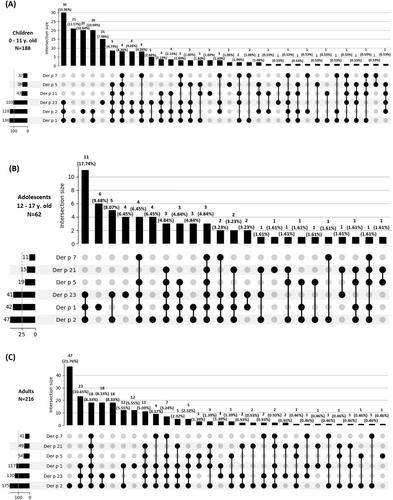Sensitization profiles to house dust mite Dermatophagoides pteronyssinus molecular allergens in the Lithuanian population: Understanding allergic sensitization patterns
Abstract
Background
House dust mite (HDM) allergy is a prevalent global health concern, with varying sensitization profiles observed across populations. We aimed to provide a comprehensive assessment of molecular allergen sensitization patterns in the Lithuanian population, with a focus on Dermatophagoides pteronyssinus (Der p), and investigate patterns of concomitant reactivity among different allergens to enhance the accuracy of HDM allergy diagnostics.
Methods
A comprehensive analysis of 1520 patient test results in Lithuania from 2020 to 2022 was performed. Sensitization patterns to major (Der p 1, Der p 2, and Der p 23) and minor (Der p 5, Der p 7, and Der p 21) Der p allergen components were described using molecular-based diagnostics. Additionally, we investigated sensitization to allergen components from other allergen sources, including tropomyosins (Der p 10, Per a 7, Pen m 1, Ani s 3, Blo t 10) and arginine kinases (Pen m 2, Bla g 9, Der p 20).
Results
This study reveals a high prevalence of HDM sensitization in Lithuania - 481 individuals (45.38% of the sensitized group) exhibited sensitization to at least one Der p allergen component. Importantly, within the sensitized group, 37.21% of patients were sensitized to Der p 5, Der p 7, or Der p 21 in addition to major allergenic components. Distinct sensitization patterns were observed across different age groups, indicating the influence of age-related factors. Furthermore, we confirmed cross-reactivity between Der p 5 and Blo t 5 as well as between Der p 21 and Blo t 21, emphasizing the clinical relevance of these associations. We also highlighted the complexity of sensitization patterns among tropomyosins and arginine kinases.
Conclusion
This study provides valuable insights into HDM allergy sensitization profiles in Lithuania, emphasizing the importance of considering major and minor HDM allergen components for accurate diagnosis and management of HDM-related allergic diseases. Differences between populations and age-related factors impact sensitization patterns. Understanding concomitant reactivity among allergens, such as Der p 5 and Blo t 5, Der p 21 and Blo t 21, tropomyosins, and arginine kinases, is crucial for improving diagnostic strategies and developing targeted interventions for allergic individuals.


 求助内容:
求助内容: 应助结果提醒方式:
应助结果提醒方式:


